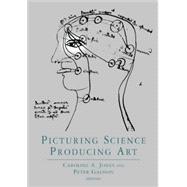
Picturing Science, Producing Art
by Galison,Peter; Galison,PeterBuy New
Rent Textbook
Rent Digital
Used Textbook
We're Sorry
Sold Out
How Marketplace Works:
- This item is offered by an independent seller and not shipped from our warehouse
- Item details like edition and cover design may differ from our description; see seller's comments before ordering.
- Sellers much confirm and ship within two business days; otherwise, the order will be cancelled and refunded.
- Marketplace purchases cannot be returned to eCampus.com. Contact the seller directly for inquiries; if no response within two days, contact customer service.
- Additional shipping costs apply to Marketplace purchases. Review shipping costs at checkout.
Summary
Table of Contents
| Table of Contents | |
| Introduction | |
| Styles | |
| Style as Inclusion, Style as Exclusion | |
| The Affective Properties of Styles: An Inquiry into Analytical Process and the Inscription of Meaning in Art History | |
| Style/Type/Standard: The Production of Technological Resemblance | |
| The Body | |
| Miracles of Bodily Transformation, or, HOw St. Francis Recieved the Stigmata | |
| Lost Knowledge, Bodies of Ignorance, and the Poverty of Taxonomy as Illustrated by the Curious Fate of Flos Pavonis an Abortifacient | |
| The Sex of the Machine: Mechanomorphic Art, New Women, and Francis Picabia's Neurasthenic | |
| Deanimations: Maps and Portraits of Life Itself | |
| Seeing Wonder | |
| Vision and Cognition | |
| Nature by Design | |
| Impressed Images:Reproducing Wonders | |
| Iconography Between the History of Art and the History of Science: Art, Science, and the Case of the Urban | |
| Hieronymus Bosch's World Picture | |
| Objectivity/Subjectivity | |
| Judgment Against Objectivity | |
| Eclectic Subjectivity and the Impossibility of Female Beauty | |
| Visualization and Visibility | |
| Cultures of Vision | |
| The Studio, the Laboratory, and the Vexations of Art | |
| How to Be Iconophilic in Art, Science, and Religion? | |
| On Astronomical Drawing | |
| Attention and Modernity in the Ninteenth Century | |
| Table of Contents provided by Publisher. All Rights Reserved. |
An electronic version of this book is available through VitalSource.
This book is viewable on PC, Mac, iPhone, iPad, iPod Touch, and most smartphones.
By purchasing, you will be able to view this book online, as well as download it, for the chosen number of days.
Digital License
You are licensing a digital product for a set duration. Durations are set forth in the product description, with "Lifetime" typically meaning five (5) years of online access and permanent download to a supported device. All licenses are non-transferable.
More details can be found here.
A downloadable version of this book is available through the eCampus Reader or compatible Adobe readers.
Applications are available on iOS, Android, PC, Mac, and Windows Mobile platforms.
Please view the compatibility matrix prior to purchase.
